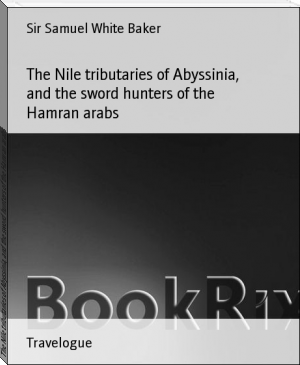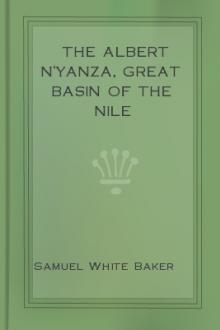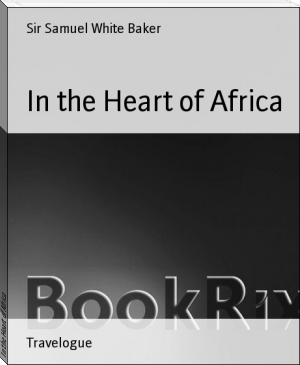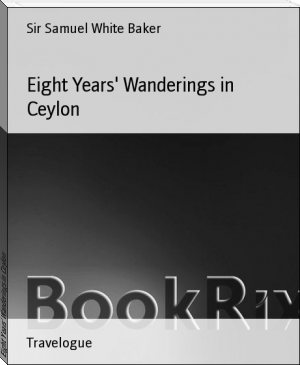The Nile tributaries of Abyssinia, and the sword hunters of the Hamran arabs by Sir Samuel White Baker (e book reader online .TXT) 📕

- Author: Sir Samuel White Baker
Book online «The Nile tributaries of Abyssinia, and the sword hunters of the Hamran arabs by Sir Samuel White Baker (e book reader online .TXT) 📕». Author Sir Samuel White Baker
a great shrieking of women on the opposite side, in the spot from which the people of Sofi fetch their water. About a dozen women had been filling their water-skins, when suddenly they were attacked by a large crocodile, who attempted to seize a woman, but she, springing back, avoided it, and the animal swallowed her girba (water-skin), that, being full of water and of a brown exterior, resembled the body of a woman. The women rushed out of the river, when the crocodile made a second dash at them, and seized another water-skin that a woman had dropped in her flight. They believe this to be the same monster that took a woman a few months ago. Few creatures are so sly and wary as the crocodile. I watch them continually as they attack the dense flocks of small birds that throng the bushes at the water's edge. These birds are perfectly aware of the danger, and they fly from the attack, if possible. The crocodile then quietly and innocently lies upon the surface, as though it had appeared quite by an accident; it thus attracts the attention of the birds, and it slowly sails away to a considerable distance, exposed to their view. The birds, thus beguiled by the deceiver, believe that the danger is removed, and they again flock to the bush, and once more dip their thirsty beaks into the stream. Thus absorbed in slaking their thirst, they do not observe that their enemy is no longer on the surface. A sudden splash, followed by a huge pair of jaws beneath the bush that engulfs some dozens of victims, is the signal unexpectedly given of the crocodile's return, who has thus slyly dived, and hastened under cover of water to his victims. I have seen the crocodiles repeat this manoeuvre constantly; they deceive by a feigned retreat, and then attack from below.
"In like manner the crocodile perceives, while it is floating on the surface in mid-stream, or from the opposite side of the river, a woman filling her girba, or an animal drinking, &c. &c. Sinking immediately, it swims perhaps a hundred yards nearer, and again appearing for an instant upon the surface, it assures itself of the position of its prey by a stealthy look; once more it sinks, and reaches the exact spot above which the person or animal may be. Seeing distinctly through the water, it generally makes its fatal rush from beneath--sometimes seizing with its jaws, and at other times striking the object into the water with its tail, after which it is seized and carried off.
"The crocodile does not attempt to swallow a large prey at once, but generally carries it away and keeps it for a considerable time in its jaws in some deep hole beneath a rock, or the root of a tree, where it eats it at leisure. The tongue of the crocodile is so unlike that of any other creature that it can hardly be called by the same name; no portion throughout the entire length is detached from the flesh of the lower jaw--it is more like a thickened membrane from the gullet to about half way along the length of jaw.
"October 4.--Having burnt off a large surface of high grass, I discovered a quantity of gourds and wild cucumbers--the latter are bright crimson, covered with long fleshy prickles, with black horny tips; these are eaten by the baboons, but not by the Arabs. The gourds are only serviceable for cups and ladles manufactured from their shells.
"I find a good pair of Highland shooting shoes of great value; the soles were exceedingly thick, and they have resisted, until now, the intensely hard and coarse-grained sandstone which grinds through all leather. My soles are at length worn out, and I have repaired them with the tanned hide of giraffe. Much of the sandstone is white and soft and friable; but this appears to have been decomposed by time and exposure, as the generality is hard and would make excellent grindstones.
"October 25.--Three elephant-hunters arrived to-day with horses for sale. I purchased three--a bay and two greys. They are all of Abyssinian breed, and are handsome animals, although none exceed fourteen hands and a half. The prices were high for this part of the world where dollars are scarce; but to me, they appeared to be absurdly cheap. The bay horse was a regular strong-built cob; for him I paid nineteen dollars--about 4l. including a native saddle and bridle; for the greys, I paid fifteen and thirteen dollars, saddles and bridles also included. The bay I named Tetel (hartebeest), the greys Aggahr* and Gazelle. Tetel was a trained hunter, as was Aggahr likewise. Gazelle was quite inexperienced, but remarkably handsome. None of these horses had ever been shod, but their hoofs were beautifully shaped, and as hard as ivory. The saddles had no stuffing on the seats, but were simple wooden frames, with high backs and pommels, the various pieces being sewn together with raw hide, and the front and back covered with crocodile skin. The stirrups were simple iron rings, sufficiently large to admit the great toe of the rider, according to Arab fashion in these parts. The bits were dreadfully severe; but perhaps not unnecessarily, as the sword allows only one bridle-hand to a pulling horse. Each horse was furnished with a leathern nose-bag, and a long leathern thong as a picket strap. All these horses and saddlery I had purchased for forty-seven dollars, or 9l. 1Os. Fortunately, both my wife and I were well provided with the best English saddles, bridles, &c. or the 'big toe' stirrup would have been an awkward necessity.
* Aggahr is the designation of a hunter with the sword.
"October 26.--We left our camp this morning for a few days' reconnaissance of the country, accompanied by Florian, prior to commencing our regular expedition. Nine miles S.E. of Ehetilla we passed through a village called Wat el Negur, after which we continued along a great tract of table land, on the eastern side of the Atbara valley, bounded by a mimosa forest about four miles on the east. Very large quantities of dhurra (Sorghum vulgare) are grown upon this fertile soil; it is now higher than a man's head when mounted upon a camel. Far as the eye can reach, the great table lands extend on either side the broad valley of the Atbara. The cotton that was planted many years ago by the inhabitants who have vanished, still flourishes, although choked with grass six or seven feet high. At 4 P.M. we reached a large village, Sherif el Ibrahim, twenty-eight miles S.E. from Sofi by the route upon the east bank of the Atbara, which cuts off a bend in the river. A species of dhurra, as sweet as the sugar-cane, grows here in abundance, being regularly sown and cultivated; it is called ankoleep. This is generally chewed in the mouth as a cane; but it is also peeled by the women, and, when dried, it is boiled with milk to give it sweetness. A grain called dochan, a species of millet, is likewise cultivated to a considerable extent; when ripe, it somewhat resembles the head of the bulrush. The whole of this country would grow cotton and sugar to perfection.
"October 28.--Having slept at the village, we went to the river, and Florian shot a hippopotamus. The natives, having skinned it, rushed at the carcase with knives and axes, and fought over it like a pack of wolves; neither did they leave the spot until they had severed each bone, and walked off with every morsel, of this immense beast.
"October 31.--Having passed a couple of days at Sherif el Ibrahim, we started for the Settite. When about half way, we arrived at a curious plateau of granite rock, with a pool of water in the centre. Formerly a large village occupied this position, named Gerrarat; but it was destroyed in a raid by the Egyptians, as being one of Mek Nimmur's strongholds. The rock is a flat surface of about five acres, covered with large detached fragments of granite; near this are several pools of water, which form the source of the rivulet, the Till, that bounds our camp at Ehetilla. A large homera-tree (Adansonia digitata) grows among the blocks of granite by the pool; in the shade of its enormous boughs we breakfasted, and again started at 4 P.M. reaching the Settite river at 7.3O, at a spot named Geera. In the dark we had some difficulty in finding our way down the rugged slopes of the valley to the river. We had not taken beds, as these incumbrances were unnecessary when in light marching order. We therefore made separate bivouacs, Florian and his people about a hundred yards distant, while a rug laid upon the ground was sufficient for my wife. I made myself comfortable in a similar manner. Lions were roaring all night.
"On the following morning we took a long stroll along the wild and rugged valley of the Settite, that was precisely similar to that of the Atbara. The river, although low, was a noble stream, and the water was at this season beautifully clear as it ran over a bed of clean pebbles. The pass between the cliffs of Geera was exceedingly lovely. At that point the river did not exceed 200 yards in width, and it flowed through abrupt cliffs of beautiful rose-coloured limestone; so fine and pure was the surface of the stone, that in places it resembled artificially-smoothed marble; in other places, the cliffs, equally abrupt, were of milk-white limestone of similar quality. This was the first spot in which I had found limestone since I had left Lower Egypt. The name 'Geera,' in Arabic, signifies lime. Formerly this was an important village belonging to Mek Nimmur, but it had been destroyed by the Egyptians, and the renowned Mek Nimmur was obliged to fall back to the strongholds of the mountains.
"I started off a man to recall Mahomet and my entire camp fronm Ehetilla to Wat el Negur, as that village was only seven hours' march from Geera; the three points, Sherif el Ibrahim, Geera, and Wat el Negur formed almost an equilateral triangle. We reached the latter village on the following day, and found that Mahomet and a string of camels from Sofi had already arrived. The country was now thickly populated on the west bank of the Atbara, as the Arabs and their flocks had returned after the disappearance of the seroot fly. Mahomet had had an accident, having fallen from his camel and broken no bones, but he had smashed the stock of my single-barrel rifle; this was in two pieces; I mended it, and it become stronger than ever. The wood had broken short off in the neck of the stock, I therefore bored a hole about three inches deep up the centre of either piece, so that it was hollowed like a marrow-bone; in one of them I inserted a piece of an iron ramrod, red-hot, I then drew the other piece over the iron in a similar manner, and gently tapped the shoulder-plate until I had driven the broken joint firmly together. I then took off from a couple of old boxes two strong brass hasps; these I let neatly into the wood on each side of the broken stock, and secured them by screws, filing off all projections, so that they fitted exactly. I finished the work by stretching a piece of well-soaked crocodile's skin over the joint, which, when drawn tight, I sewed strongly together. When this dried it became as hard as horn, and very much stronger; the extreme contraction held the work together like a vice, and my rifle was perfectly restored. A traveller in wild countries should always preserve
"In like manner the crocodile perceives, while it is floating on the surface in mid-stream, or from the opposite side of the river, a woman filling her girba, or an animal drinking, &c. &c. Sinking immediately, it swims perhaps a hundred yards nearer, and again appearing for an instant upon the surface, it assures itself of the position of its prey by a stealthy look; once more it sinks, and reaches the exact spot above which the person or animal may be. Seeing distinctly through the water, it generally makes its fatal rush from beneath--sometimes seizing with its jaws, and at other times striking the object into the water with its tail, after which it is seized and carried off.
"The crocodile does not attempt to swallow a large prey at once, but generally carries it away and keeps it for a considerable time in its jaws in some deep hole beneath a rock, or the root of a tree, where it eats it at leisure. The tongue of the crocodile is so unlike that of any other creature that it can hardly be called by the same name; no portion throughout the entire length is detached from the flesh of the lower jaw--it is more like a thickened membrane from the gullet to about half way along the length of jaw.
"October 4.--Having burnt off a large surface of high grass, I discovered a quantity of gourds and wild cucumbers--the latter are bright crimson, covered with long fleshy prickles, with black horny tips; these are eaten by the baboons, but not by the Arabs. The gourds are only serviceable for cups and ladles manufactured from their shells.
"I find a good pair of Highland shooting shoes of great value; the soles were exceedingly thick, and they have resisted, until now, the intensely hard and coarse-grained sandstone which grinds through all leather. My soles are at length worn out, and I have repaired them with the tanned hide of giraffe. Much of the sandstone is white and soft and friable; but this appears to have been decomposed by time and exposure, as the generality is hard and would make excellent grindstones.
"October 25.--Three elephant-hunters arrived to-day with horses for sale. I purchased three--a bay and two greys. They are all of Abyssinian breed, and are handsome animals, although none exceed fourteen hands and a half. The prices were high for this part of the world where dollars are scarce; but to me, they appeared to be absurdly cheap. The bay horse was a regular strong-built cob; for him I paid nineteen dollars--about 4l. including a native saddle and bridle; for the greys, I paid fifteen and thirteen dollars, saddles and bridles also included. The bay I named Tetel (hartebeest), the greys Aggahr* and Gazelle. Tetel was a trained hunter, as was Aggahr likewise. Gazelle was quite inexperienced, but remarkably handsome. None of these horses had ever been shod, but their hoofs were beautifully shaped, and as hard as ivory. The saddles had no stuffing on the seats, but were simple wooden frames, with high backs and pommels, the various pieces being sewn together with raw hide, and the front and back covered with crocodile skin. The stirrups were simple iron rings, sufficiently large to admit the great toe of the rider, according to Arab fashion in these parts. The bits were dreadfully severe; but perhaps not unnecessarily, as the sword allows only one bridle-hand to a pulling horse. Each horse was furnished with a leathern nose-bag, and a long leathern thong as a picket strap. All these horses and saddlery I had purchased for forty-seven dollars, or 9l. 1Os. Fortunately, both my wife and I were well provided with the best English saddles, bridles, &c. or the 'big toe' stirrup would have been an awkward necessity.
* Aggahr is the designation of a hunter with the sword.
"October 26.--We left our camp this morning for a few days' reconnaissance of the country, accompanied by Florian, prior to commencing our regular expedition. Nine miles S.E. of Ehetilla we passed through a village called Wat el Negur, after which we continued along a great tract of table land, on the eastern side of the Atbara valley, bounded by a mimosa forest about four miles on the east. Very large quantities of dhurra (Sorghum vulgare) are grown upon this fertile soil; it is now higher than a man's head when mounted upon a camel. Far as the eye can reach, the great table lands extend on either side the broad valley of the Atbara. The cotton that was planted many years ago by the inhabitants who have vanished, still flourishes, although choked with grass six or seven feet high. At 4 P.M. we reached a large village, Sherif el Ibrahim, twenty-eight miles S.E. from Sofi by the route upon the east bank of the Atbara, which cuts off a bend in the river. A species of dhurra, as sweet as the sugar-cane, grows here in abundance, being regularly sown and cultivated; it is called ankoleep. This is generally chewed in the mouth as a cane; but it is also peeled by the women, and, when dried, it is boiled with milk to give it sweetness. A grain called dochan, a species of millet, is likewise cultivated to a considerable extent; when ripe, it somewhat resembles the head of the bulrush. The whole of this country would grow cotton and sugar to perfection.
"October 28.--Having slept at the village, we went to the river, and Florian shot a hippopotamus. The natives, having skinned it, rushed at the carcase with knives and axes, and fought over it like a pack of wolves; neither did they leave the spot until they had severed each bone, and walked off with every morsel, of this immense beast.
"October 31.--Having passed a couple of days at Sherif el Ibrahim, we started for the Settite. When about half way, we arrived at a curious plateau of granite rock, with a pool of water in the centre. Formerly a large village occupied this position, named Gerrarat; but it was destroyed in a raid by the Egyptians, as being one of Mek Nimmur's strongholds. The rock is a flat surface of about five acres, covered with large detached fragments of granite; near this are several pools of water, which form the source of the rivulet, the Till, that bounds our camp at Ehetilla. A large homera-tree (Adansonia digitata) grows among the blocks of granite by the pool; in the shade of its enormous boughs we breakfasted, and again started at 4 P.M. reaching the Settite river at 7.3O, at a spot named Geera. In the dark we had some difficulty in finding our way down the rugged slopes of the valley to the river. We had not taken beds, as these incumbrances were unnecessary when in light marching order. We therefore made separate bivouacs, Florian and his people about a hundred yards distant, while a rug laid upon the ground was sufficient for my wife. I made myself comfortable in a similar manner. Lions were roaring all night.
"On the following morning we took a long stroll along the wild and rugged valley of the Settite, that was precisely similar to that of the Atbara. The river, although low, was a noble stream, and the water was at this season beautifully clear as it ran over a bed of clean pebbles. The pass between the cliffs of Geera was exceedingly lovely. At that point the river did not exceed 200 yards in width, and it flowed through abrupt cliffs of beautiful rose-coloured limestone; so fine and pure was the surface of the stone, that in places it resembled artificially-smoothed marble; in other places, the cliffs, equally abrupt, were of milk-white limestone of similar quality. This was the first spot in which I had found limestone since I had left Lower Egypt. The name 'Geera,' in Arabic, signifies lime. Formerly this was an important village belonging to Mek Nimmur, but it had been destroyed by the Egyptians, and the renowned Mek Nimmur was obliged to fall back to the strongholds of the mountains.
"I started off a man to recall Mahomet and my entire camp fronm Ehetilla to Wat el Negur, as that village was only seven hours' march from Geera; the three points, Sherif el Ibrahim, Geera, and Wat el Negur formed almost an equilateral triangle. We reached the latter village on the following day, and found that Mahomet and a string of camels from Sofi had already arrived. The country was now thickly populated on the west bank of the Atbara, as the Arabs and their flocks had returned after the disappearance of the seroot fly. Mahomet had had an accident, having fallen from his camel and broken no bones, but he had smashed the stock of my single-barrel rifle; this was in two pieces; I mended it, and it become stronger than ever. The wood had broken short off in the neck of the stock, I therefore bored a hole about three inches deep up the centre of either piece, so that it was hollowed like a marrow-bone; in one of them I inserted a piece of an iron ramrod, red-hot, I then drew the other piece over the iron in a similar manner, and gently tapped the shoulder-plate until I had driven the broken joint firmly together. I then took off from a couple of old boxes two strong brass hasps; these I let neatly into the wood on each side of the broken stock, and secured them by screws, filing off all projections, so that they fitted exactly. I finished the work by stretching a piece of well-soaked crocodile's skin over the joint, which, when drawn tight, I sewed strongly together. When this dried it became as hard as horn, and very much stronger; the extreme contraction held the work together like a vice, and my rifle was perfectly restored. A traveller in wild countries should always preserve
Free e-book «The Nile tributaries of Abyssinia, and the sword hunters of the Hamran arabs by Sir Samuel White Baker (e book reader online .TXT) 📕» - read online now
Similar e-books:





Comments (0)